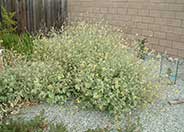
Common name:Indian Mallow
Botanical name:Abutilon palmeri
Herbaceous shrub with velvety, heart-shaped leaves. Grows quickly to 4'-5' tall and 3' wide. Good for subtropical effect. Plant it next to a patio to enjoy soft texture. Takes full sun or partial shade. Takes reflected heat. May freeze in colder climates. Cup-shaped, apricot-colored blooms on and off during warm months. Arizona Native as well as in low Sonoran Desert in Southern California.
Maintenance Tips
Abutilon palmeri is a fast-growing, California native shrub that has a very dense, but irregular, growth habit. It can get 4-5' tall in one growing season but can continue to grow up to 8' tall and wide if left alone. The majority of the maintenance on this plant is pruning to shape it and keep it in the desired space. One of the best ways to keep the maintenance as low as possible is to give it plenty of room to reach its mature size. If other plants are crowing it out, transplant those other plants further away. This plant can thrive in both full sun and partial shade, but it does not like a wet root system. If it is planted in a shady area, make sure the soil isn’t collecting or retaining moisture. Also, shady areas will result in a taller, rangy plant, so it may require some pruning to encourage lower growth.
Common name:Sundrops
Botanical name:Calylophus hartwegii
This low-growing perennial grows 1' tall and 3' tall; it has woody stems with bright green leaves. It produces large, lemon yellow flowers that are up to 4" across and bloom spring through summer and possibly through fall, depending on weather conditions.
Maintenance Tips
Calylophus hartwegii is a soft-textured, low-growing perennial with bright yellow flowers. It only grows 12" tall and up to 3' wide. It is very fast growing in the late winter and early spring, and then it is covered with flowers from mid-spring until fall if the weather is ideal. In the fall, when the days start to get shorter and the rains begin, this plant can decline. The root system will stay intact, but the flowering stops, and the foliage will completely die back. This plant benefits from hard pruning, taking the foliage, and branching almost down to the ground. Don't expect any new growth to emerge until the days start to get longer and warm up. The foliage will start to emerge, and the plant's quick growth and blooming cycle will return.Designer: Susan Trindle
Photographer: GardenSoft
Physical weed control, including mulching, or hand removal protects the watershed from harmful chemicals.
Be sure to fix all leaks promptly no matter how small they may seem.
Drip and other smart irrigation delivers water directly to roots, allowing no excess water for weeds.